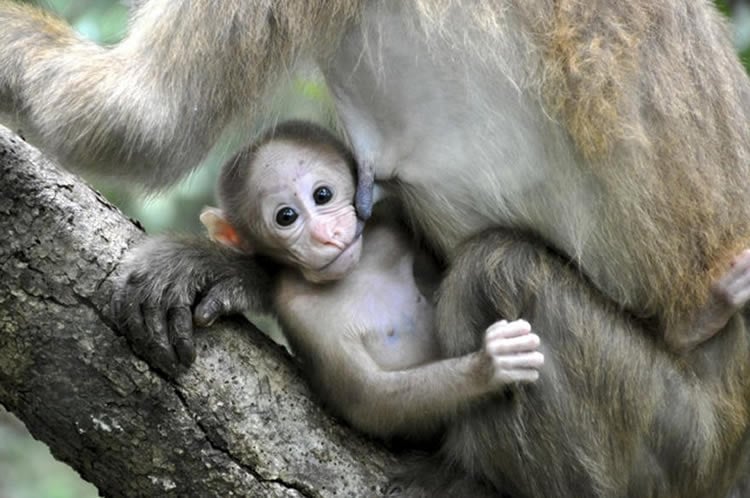Summary: A new study using non-human primates found infants of mothers who were stressed during pregnancy grew faster but had slower motor development than their peers.
Source: DPZ.
For the first time, behavioral ecologists studied the impact of maternal stress on primate infants in the wild.
At their field station in Thailand, researchers of the German Primate Center – Leibniz Institute for Primate Research (DPZ) and the University of Göttingen followed non-human primate mothers through their gestation and their infants through the first one and a half years of their lives. The offspring of mothers that were stressed from food shortages grew faster than their peers but paid for that with slower motoric development and probably also a weakened immune system. This is the first study on the effects of prenatal stress in long-lived mammals in their natural habitat. The results support the theory that stressed mothers change their unborn’s pace of life. The findings are presented in Proceedings of the Royal Society B.
It is a known fact that maternal stress often has a long-term impact on the unborn child.
Yet, physicians and biologists still discuss as to whether these maternal influences should generally be regarded as pathological or as to whether it is an evolved adaptative mechanism. Are mothers able to program their unborn offspring to increase its evolutionary fitness?
This hypothesis is supported by studies on short-lived mammals such as rats, since the environmental conditions during gestation are very similar to those the offspring will breed in a few month later. The new study suggests that adaptive prenatal stress effects can also occur in long-lived monkeys. The physiological stress following natural food shortages seemed to have cause accelerated growth among young macaques as evident from the analysis of data on fruit availability in the most important tree species, hormone levels in the feces of mothers and growth curves derived from hundreds of photos of Assamese macaque infants in the hill evergreen forest of northeastern Thailand.

In mammals growth is usually closely related to important developmental milestones. The first author of the study, Andreas Berghänel, explains, “A shortened life expectancy caused by prenatal development disturbances here leads to an accelerated pace of life. The offspring grows faster and reaches sexually maturity quicker allowing for earlier and faster reproduction.” Even in humans, early life adversities are related to earlier sexual maturity. Nevertheless, Julia Ostner, the head of the field project, is surprised, “The faster pace of life is astounding. We expected that the poor conditions experienced in the womb would have only negative consequences for the young during the gestation period.”
And indeed, accelerated growth is only one of the consequences of reduced food availability and an increased glucocorticoid level. Offspring exposed to these conditions showed delayed motoric development and took longer to learn how to dangle from a branch on one leg, to jump backwards or to leap at least five meters far in the canopy of the forest. When an outbreak of conjunctivitis occurred, the external signs were noticed in the infant the longer, the more stress their mothers experienced during gestation. Thus, also the immune system seems to be affected.
It remains unclear whether the prenatal stress also affected the cognitive development of the offspring. Further investigations are needed to determine whether adverse prenatal conditions increase reproductive rates of macaques and reduce their longevity, as predicted by the hypothesis of the internal adaptive response.
This neuroscience research article was submitted directly to NeuroscienceNews.com by Luzie Julia Almenräder. We would like to thank Luzie for this submission.
Source: Luzie Julia Almenräder – DPZ
Image Source: This NeuroscienceNews.com image is credited to Andreas Berghänel.
Original Research: Abstract for “Prenatal stress effects in a wild, long-lived primate: predictive adaptive responses in an unpredictable environment” by Andreas Berghänel, Michael Heistermann, Oliver Schülke, and Julia Ostner in Proceedings of the Royal Society B. Published online September 21 2016 doi:10.1098/rspb.2016.1304
[cbtabs][cbtab title=”MLA”]DPZ. “Stimulating Neurons Could Protect Against Brain Damage.” NeuroscienceNews. NeuroscienceNews, 21 September 2016.
<https://neurosciencenews.com/prenatal-stress-motor-development-5099/>.[/cbtab][cbtab title=”APA”]DPZ. (2016, September 21). Stimulating Neurons Could Protect Against Brain Damage. NeuroscienceNews. Retrieved September 21, 2016 from https://neurosciencenews.com/prenatal-stress-motor-development-5099/[/cbtab][cbtab title=”Chicago”]DPZ. “Stimulating Neurons Could Protect Against Brain Damage.” https://neurosciencenews.com/prenatal-stress-motor-development-5099/ (accessed September 21, 2016).[/cbtab][/cbtabs]
Abstract
Prenatal stress effects in a wild, long-lived primate: predictive adaptive responses in an unpredictable environment
Prenatal maternal stress affects offspring phenotype in numerous species including humans, but it is debated whether these effects are evolutionarily adaptive. Relating stress to adverse conditions, current explanations invoke either short-term developmental constraints on offspring phenotype resulting in decelerated growth to avoid starvation, or long-term predictive adaptive responses (PARs) resulting in accelerated growth and reproduction in response to reduced life expectancies. Two PAR subtypes were proposed, acting either on predicted internal somatic states or predicted external environmental conditions, but because both affect phenotypes similarly, they are largely indistinguishable. Only external (not internal) PARs rely on high environmental stability particularly in long-lived species. We report on a crucial test case in a wild long-lived mammal, the Assamese macaque (Macaca assamensis), which evolved and lives in an unpredictable environment where external PARs are probably not advantageous. We quantified food availability, growth, motor skills, maternal caretaking style and maternal physiological stress from faecal glucocorticoid measures. Prenatal maternal stress was negatively correlated to prenatal food availability and led to accelerated offspring growth accompanied by decelerated motor skill acquisition and reduced immune function. These results support the ‘internal PAR’ theory, which stresses the role of stable adverse internal somatic states rather than stable external environments.
“Prenatal stress effects in a wild, long-lived primate: predictive adaptive responses in an unpredictable environment” by Andreas Berghänel, Michael Heistermann, Oliver Schülke, and Julia Ostner in Proceedings of the Royal Society B. Published online September 21 2016 doi:10.1098/rspb.2016.1304






